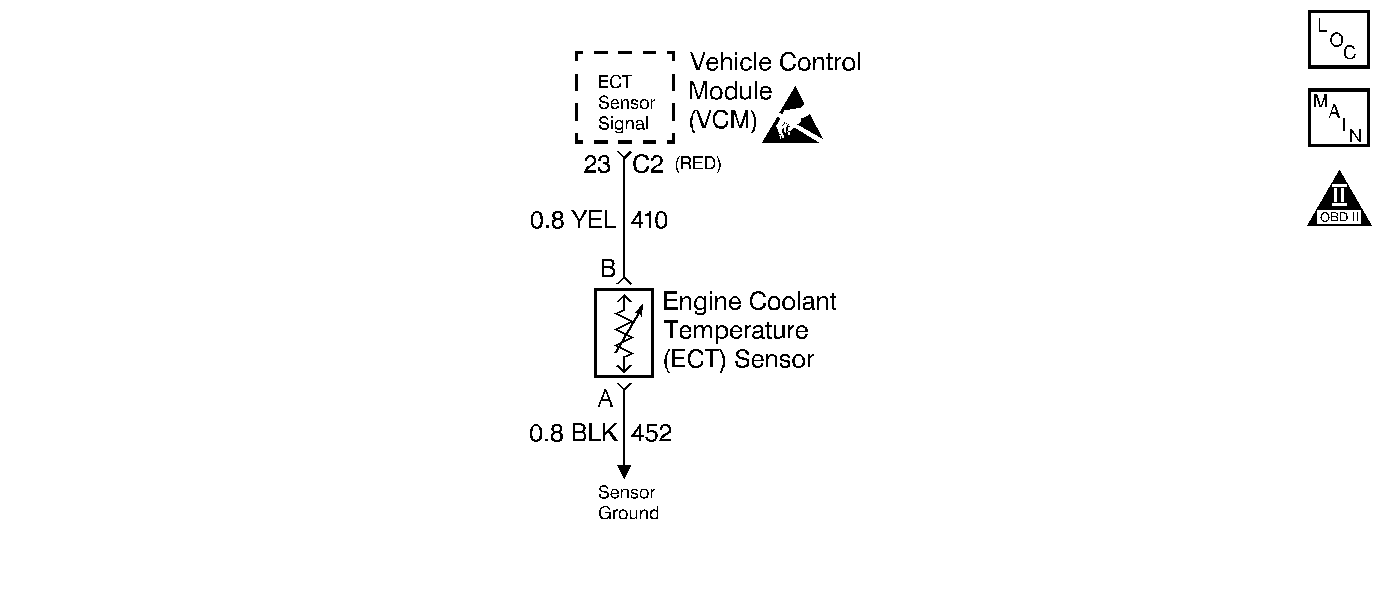
Circuit Description
While the engine is warming, the VCM monitors the ECT sensor in order to determine how long the engine takes to reach the coolant temperature that is required for closed loop operation.
A DTC sets if the VCM determines that the engine did not reach a closed loop temperature in a specified amount of time. This diagnostic will not run if either the intake air or the engine coolant temperature measure below a predetermined temperature. The VCM will only run this DTC on a cold start and only once per cold start. This DTC is a type B DTC.
Conditions for Setting the DTC
The following conditions will set the DTC:
| • | No ECT sensor test failing or DTCs |
| • | No IAT sensor DTCs |
| • | The vehicle speed greater than 5 mph |
| • | The IAT greater than -3.75°C |
| • | The ECT greater than 5.25°C |
| • | A start-up ECT less than 21.75°C |
| • | A Closed Loop timer greater than 4 minutes |
| • | The minimum stabilized ECT is less than 20.25°C. |
Action Taken When the DTC Sets
The VCM turns the MIL ON after 2 consecutive driving cycles with the fault active.
Conditions for Clearing the MIL/DTC
The VCM turns OFF the MIL after 3 consecutive driving trips without a fault condition present. A history DTC will clear if no fault conditions have been detected for 40 warm-up cycles (the coolant temperature has risen 22°C (40°F) from the start-up coolant temperature and the engine coolant temperature exceeds 71°C (160°F) during that same ignition cycle) or the scan tool clearing feature has been used.
Diagnostic Aids
When a DTC P0125 sets, a skewed ECT sensor or the engine thermostat that does not operate correctly is indicated.
A poor connection, a rubbed through wire insulation, or a wire broken inside of the insulation may cause an intermittent.
Check for the following conditions:
| • | A poor connection or a damaged harness. Inspect the VCM harness connector for the following conditions: |
| - | Backed out terminals |
| - | Improper mating |
| - | Broken locks |
| - | Improperly formed or damaged terminals |
| - | Poor terminal to wire connection and |
| - | A damaged harness |
| • | The intermittent test: If the connections and the harness check OK, monitor a digital voltmeter connected between the VCM terminals while moving the related connectors and the wiring harness. If the failure is induced, the voltage reading changes. This may help in order to isolate the location of the malfunction. |
Test Description
The numbers below refer to the step numbers in the diagnostic table.
-
This test checks the engine warm-up rate.
-
This test checks the coolant sensor reading on the scan tool and the actual coolant temperature.
Step | Action | Value(s) | Yes | No |
|---|---|---|---|---|
1 |
Important: Before clearing the DTCs use the scan tool to record the Freeze Frame and the Failure Records data. This data will be lost when the Clear Info function is used. Was the Powertrain On-Board Diagnostic (OBD) System Check performed? | -- | ||
2 |
Are they close? | -- | Go to DTC P0117 Engine Coolant Temperature (ECT) Sensor Circuit Low Voltage | |
Does the ECT value rise steadily to above the specified value within 9 minutes? | 35° C (95° F) | Go to Diagnostic Aids | ||
4 | Check the cooling system coolant level. Was a problem found? | -- | Go to Engine Cooling System | |
Compare the ECT display on the scan tool to the actual coolant temperature. The values should be close. Are they close? | -- | Go to Engine Cooling System | ||
6 | Replace the ECT sensor. Refer to Engine Coolant Temperature (ECT) Sensor Replacement . Is the replacement complete? | -- | -- | |
7 |
Does the scan tool indicate that this diagnostic ran and passed? | -- | ||
8 | Using the scan tool, select the Capture Info and the Review Info. Are any DTCs displayed that have not been diagnosed? | -- | Go to The Applicable DTC Table | System OK |
